
I love archaic formations and their battlefield applications; but I also love zombies. So I determined to take some broad generalized formations and see how they might fare against zombies. Those of you familiar with history will recognize that these formations do not give the full spread of military field tactics and are only a simplified sampling.
So let’s assume you have a military force facing off against a zombie horde of thousands or tens of thousands. A modern spread of infantry trained to shoot center mass would be effective, but maybe not the most effective defense. If you can throw together some rough armor, shields and basic weapons; might you fare better with some kind of closed formation? In the least, you would preserve ammunition for latter fights. How would you approach a battle of this scale in the open? What formations in history do you think would be most suited against zombie hordes?
Hoplite Phalanx (Yes the picture is a Macedonian Phalanx)

The hoplite phalanx of the Archaic and Classical periods in Greece (ca. 800–350 BC) was the formation in which the hoplites would line up in ranks in close order. The hoplites would lock their shields together, and the first few ranks of soldiers would project their spears out over the first rank of shields. The phalanx therefore presented a shield wall and a mass of spear points to the enemy, making frontal assaults against it very difficult. It also allowed a higher proportion of the soldiers to be actively engaged in combat at a given time (rather than just those in the front rank).
The phalanx usually advanced at a walking pace, although it is possible that they picked up speed during the last several yards. One of the main reasons for this slow approach was to maintain formation. If the phalanx lost its shape as it approached the enemy it would be rendered useless. If the hoplites of the phalanx were to pick up speed toward the latter part of the advance it would have been for the purpose of gaining momentum against the enemy in the initial collision. Herodotus states, of the Greeks at the Battle of Marathon, that “They were the first Greeks we know of to charge their enemy at a run”.
Advantages:
Multiple ranks can attack to the front at once.
Keeps zombies at a distance.
Hoplites are heavily armored from head to shins; despite what Hollywood might imply.
Hoplites often armed with xiphos, short thrusting sword used to strike specific targets between the gaps of shields and ideal for a tight pressed battle.
Large shields provided great protection.
Disadvantages:
Whether using the long sarissa, the shorter dory, or other forms of pike or spear; Greek pole arms generally lacked barbs; meaning a skewered zombie could work his way down the length of the pole.
Arguably deemed by many historians as a formation with limited motions beyond a simple advance.
Flanks are left open.
Inverted Wedge

Ironically, one of the best pictures I found for this tactic is from the Battle of the Bastards featured in Game of Thrones; though the formation starts out as a line and then wraps around the enemy.
The inverted wedge is particularly effective for encircling an enemy force, village, or other strategic objective. The leading units envelop the objective to the right and left, while the remaining unit is free to search, attack, or support one or both of the leading units as the situation requires. Arguably the most famous use of the inverted wedge was by Hannibal at the Battle of Cannae, where he surrounded the numerically superior Roman force.
Advantages:
Ideal for funneling enemy troops into a kill zone and possibly encircling them.
Disadvantages:
Vulnerable to a secondary force once a primary force is encircled.
Post Marian Reform Principes
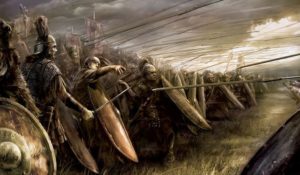
It is probable that engagements with the Samnites and a crushing defeat at the hands of the Gallic warlord Brennus, who both used lots of smaller military units rather than a few very large ones, taught the Romans the importance of flexibility and the inadequacy of the phalanx on the rough, hilly ground of central Italy.
General Roman Advantages:
Heavily armored as a secondary should the primary defense of the shield be breached.
Utilized the gladius; a short sword suitable for thrusting in a tight press of bodies, and slashing when space is provided.
Legionaries carried one or two pila, throwing javelins, to throw at the enemy prior to engaging in close combat.
Roman scutum, or an oval and later rectangular and even later oval shield, provided great bodily protection.
General Roman Disadvantages:
White there was armor developed for the arms and legs utilized in specific Roman campaigns; the average Roman Legionnaire relied on his shield as a primary defense, and provided little armor beyond the head, torso and shoulders.
Tactics generally revolved around close combat, when zombies are ideally left at a distance, though earlier Roman formations did focus more heavily on the spear and pike similar to the phalanx.
While Roman formations could act independently to great effect they were designed to be used in conjunction with other cohesive formations over the spread of a battlefield.
Testudo Formation
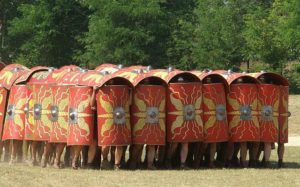
In the testudo formation, the men would align their shields to form a packed formation covered with shields on the front and top. The first row of men, possibly excluding the men on the flanks, would hold their shields from about the height of their shins to their eyes, so as to cover the formation’s front. The shields would be held in such a way that they presented a shield wall to all sides. The men in the back ranks would place their shields over their heads to protect the formation from above, balancing the shields on their helmets, overlapping them. If necessary, the legionaries on the sides and rear of the formation could stand sideways or backwards with shields held as the front rows, so as to protect the formation’s sides and rear; this reduced the speed and mobility of the formation, but offered consistent defensive strength against opposing infantry and excellent protection against arrows and other missile attacks.
Advantages:
Protects to the front and flanks.
Disadvantages:
Hampers visibility, mobility and use of arms.
Zombies do not throw spears and shoot arrows and so the overhead protection is superfluous.
Focuses on close combat.
Wedge Formation
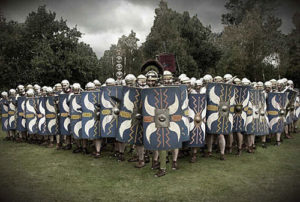
A flying wedge (also called flying V or wedge formation, or simply wedge) is a configuration created from a body moving forward in a triangular formation. This V-shaped arrangement began as a successful military strategy in ancient times when infantry units would move forward in wedge formations to smash through an enemy’s lines. The advantage of the wedge was that it offered a narrow point for piercing enemy formations and concentrated the leaders at the front. It was easier to turn than a square formation because everyone followed the leader at the apex, “like a flight of cranes”.
Advantages:
Mobility, as pointed out in the description.
Flanks are protected and not necessarily even present.
Permits more legionnaires to be on the front line when confined to a more narrow space.
Disadvantages:
Focuses on close combat.
Early Medieval Shield Wall
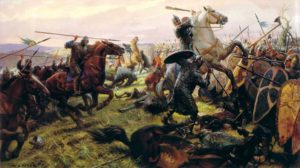
The shield-wall was commonly used in many parts of Northern Europe; and made famous in England and Scandinavia.
In the battles between the Anglo-Saxons and the Danes in England, most of the Saxon army would have consisted of the inexperienced Fyrd — a militia composed of middle class freemen. The shield-wall tactic suited such soldiers, as it did not require extraordinary skill, being essentially a shoving and fencing match with weapons.
The first three ranks of the main wall would have been made up of select warriors, such as Huscarls and Thegns, who carried heavier weapons and consistently wore armor. There would also have been nobles, such as Thegns and Earls, who would have had their own armored retainers and bodyguards.[citation needed] However, the vast majority of opponents in such battles were armed with spears, which they used against the unprotected legs or faces of their opponents. Often, soldiers would use their weapons to support each other by stabbing and slashing to the left or the right, rather than just ahead. Short weapons, such as the ubiquitous seax, could also be used in the tight quarters of the wall. Limited use of archery and thrown missile weapons occurred in opening stages of shield-wall battles, but were rarely decisive to the outcome.
Advantages:
While movies portray Vikings and Saxons using swords and axes as their primary weapons, most warriors of the time were armed with spears.
Shield wall shape is not regimented and can be formed to match geographical contours or battlefield necessity.
Mail was being used to cover the majority of the body and face when available, providing excellent armor.
While round shields provided adequate protection, the invention of the kite shield would add an element of lower body protection leading into 1066 and beyond.
Disadvantages:
The drawback of the shield-wall tactic was that, once breached, the whole affair tended to fall apart rather quickly. Relatively lightly trained fyrdmen gained morale from being shoulder-to-shoulder with their comrades, but often fled once this was compromised. Once the wall was breached, it could prove difficult or impossible to re-establish a defensive line, and panic might well set in among the defenders.
Barbs were used extensively by northern Europeans at this time on boar and bear spears for hunting; but show little to no use in combat.
Spears utilized were generally shorter thrusting spears.
Pike Square

The pike square (German: Gevierthaufen or Gewalthaufen, meaning crowd of force) was a military tactic developed by the Swiss Confederacy during the 15th century for use by its infantry.
The pike square was used to devastating effect at the Battle of Nancy against Charles the Bold of Burgundy in 1477, when the Swiss defeated a smaller but more powerful armored cavalry force. The battle is generally seen as one of the turning points that established the infantry as the primary fighting arm in European warfare from the 16th century onwards.
A pike square generally consisted of about 100 men in a 10×10 formation. While on the move, the pike would be carried vertically. However, the troops were drilled to be able to point their pikes in any direction while stationary, with the men in the front of the formation kneeling to allow the men in the center or back to point their pikes over their heads. While stationary, the staff of each pike could be butted against the ground, giving it resistance against attack. Squares could be joined together to form a battle line. If surrounded, pikes could still be pointed in all directions. A well drilled square could change direction very quickly, making it difficult to outmaneuver on horseback.
Advantages:
Extreme length of pole arms keeps zombies at a maximum distance.
To defeat cavalry most polearms periodically featured barbs of one form or another.
Direction of pikes could be changed to flanks or to the rear quickly without shifting the formation.
Disadvantages:
Armor generally limited to torso and helmet.
Shields generally abandoned in favor of longer pole arms requiring both hands.
Not designed for close combat.
Line Infantry
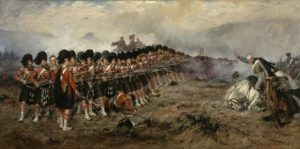
Line infantry is the type of infantry that composed the basis of European land armies from the middle of the 17th century to the middle of the 19th century. For both battle and parade drill it consisted of 2 to 4 ranks of foot soldiers drawn up side by side in rigid alignment, and thereby maximizing the effect of their firepower. By extension, the term came to be applied to the regular regiments “of the line” as opposed to skirmishers, foot guards, militia and other special categories of infantry.
Advantages:
Key battles have been won by massed fire from line formations as they bring to bear the maximum volume of fire power available.
Ideally suited for firearms with a limited range and focusing inaccurate fire on designated targets; or troops with limited firepower experience.
Drill lines can wheel and maneuver to face different threats.
Line infantry could swiftly adopt square formations to provide protection.
Disadvantages:
The bulk of the line infantry had no protective equipment, as armor that could provide protection from musket fire were considered too expensive and heavy. Only the former elite troops could keep by tradition some elements of protection, for example, the copper mitre caps of grenadiers.
Designed primarily for ranged fighting and not close combat.
Movement in line formation was very slow, and unless the battalion was superbly trained, a breakdown in cohesion was virtually assured, especially in any kind of uneven or wooded terrain. As a result, line was mostly used as a stationary formation, with troops moving in column formations and then deploying to line at their destination.
Infantry Squares
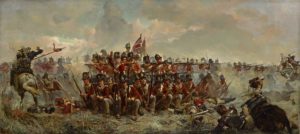
At the Battle of Waterloo Wellington’s infantry responded by forming squares (hollow box-formations four ranks deep). Squares were much smaller than usually depicted in paintings of the battle – a 500-man battalion square would have been no more than 60 feet (18 m) in length on a side. Squares that stood their ground were deadly to cavalry, as cavalry could not engage with soldiers behind a hedge of bayonets. Horses would not charge a square, nor could they be outflanked, but they were vulnerable to artillery or infantry. Wellington ordered his artillery crews to take shelter within the squares as the cavalry approached, and to return to their guns and resume fire as they retreated.
Advantages:
Front, flanks, and rear are all protected.
Provides a safe space for other personnel to gather within.
Relies on both musket fire and bayonets for close combat.
Bayonets are effective at stabbing faces.
Disadvantages:
Muskets, as with most fire arms, have limited effect against zombies when trying to strike small targets at any significant distance without proper training.
No armor for close combat.
Not ideal for holding back a large press of bodies once engaged in close combat.
Does not bring all firearms to bear, often limiting firing efficiency to twenty-five percent effect.
Modern Riot Control Shield Walls
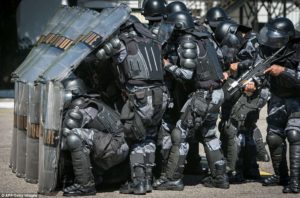
Although largely obsolete as a military tactic due to firearms, a wall of riot shields remains a common formation for riot police worldwide where firearms are not expected, but protection is required against large groups using improvised weapons, punches and kicks – and from thrown objects, such as bricks, bottles, Molotov cocktails, or other items that pose a threat.
Advantages:
Plexiglas shields allow for good visibility.
Large size of the shields offer good bodily protection.
Riot control body armor is lightweight and provides good body and face coverage against zombies.
Blunt force trauma weapons ideal for incapacitating zombies and will not become lodged or stuck as some earlier thrusting weapons.
Disadvantages:
Focuses on close combat.

Leave a Reply